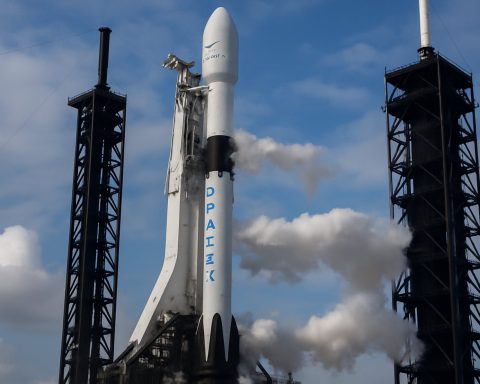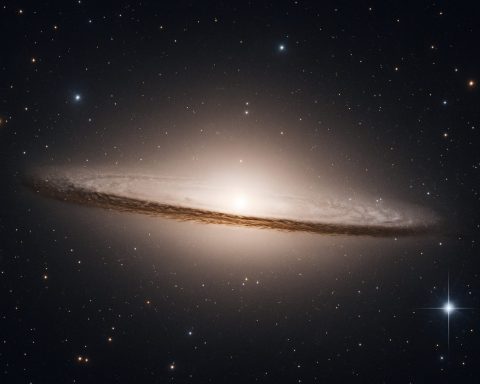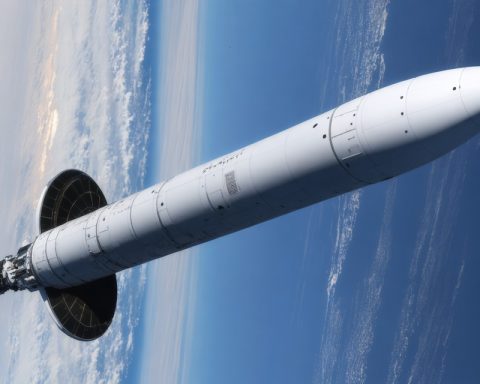- Katy Perry embarks on a historic space journey with Blue Origin, marking her debut in space tourism and reinforcing gender representation.
- The mission features notable women: Aisha Bowe, Amanda Nguyen, Kerianne Flynn, Gayle King, and Lauren Sánchez.
- This flight sets a milestone since Valentina Tereshkova’s solo journey in 1963, highlighting women’s limitless potential in space exploration.
- The trip launches from West Texas, crossing the Kármán line, and offers an awe-inspiring view of Earth from 100 kilometers above.
- Blue Origin’s New Shepard rocket operates autonomously, showcasing technological excellence in space travel.
- This venture symbolizes humanity’s achievements, making space an achievable frontier and redefining possibilities.
As dawn breaks over the vast Texan landscape, a scene reminiscent of science fiction unfolds not from a movie, but in reality. Katy Perry, the chart-topping musician known for her anthems that dare the ordinary (think “E.T.”), occupies the second seat in the gleaming Blue Origin capsule. This historic moment marks her debut not on the stage but in the vast vacuum of space—an experience most dream of but few attain.
The audacious venture aboard Jeff Bezos’ Blue Origin, an emblem of futuristic exploration and ambition, isn’t purely about celebrity fanfare. It signifies a stride in space tourism and gender representation. Perry’s announcement of the venture, brimming with nostalgia and wonder, captured the essence of a child’s imagination unfettered by boundaries, now realized through this celestial odyssey.
Equally notable are the remarkable women joining Perry on this epochal flight. Among them, a mosaic of trailblazers: former NASA rocket scientist Aisha Bowe, formidable civil rights activist Amanda Nguyen, visionary film producer Kerianne Flynn, dynamic TV presenter Gayle King, and Lauren Sánchez, the accomplished fiancée of Bezos. Together, they form a beacon for aspiring adventurers, uniting diverse backgrounds and showcasing the limitless potential of women—a rare ensemble taking to the skies since the storied solo journey of Soviet cosmonaut Valentina Tereshkova in 1963.
Launching from the arid plains of West Texas, their journey epitomizes the excitement and fragility of space travel. As the Earth falls away, these six women transcend the everyday, hurtling beyond the Kármán line, the invisible border demarcating Earth from space. In mere minutes, they will reach 100 kilometers above our planet, an 11-minute dance with the cosmos, revealing the awe-inspiring curve of Earth in unforgettable clarity.
Behind the scenes, technological prowess weaves the magic. The New Shepard rocket operates autonomously, guiding them with precision through the void, illustrating human ingenuity at its finest. This meticulous choreography culminates in a gravity-defying return: cushioned descents via parachutes, the smart booster landing upright, two miles from its origin.
Yet, beyond the technical marvel and celebrity spectacle, this journey is a testament to what humanity can achieve. It defies the bounds of what once was and introduces a new era where space is not a distant dream but an achievable frontier for all.
Perry, with her ‘Taking Up Space’ crew, is not merely singing amongst the stars; they are setting a new chapter in humanity’s galactic narrative. As we look beyond, one message resounds loud and clear: whether in music or in exploring the stars, dreams chased with tenacity redefine the limits of possibility.
Katy Perry Joins a Historic All-Female Space Mission: What You Need to Know
As Katy Perry embarks on an unprecedented journey with Blue Origin, much of the buzz centers around the celebrity aspect and the technological triumphs involved. However, there’s much more beneath the surface. This venture signifies a pivotal advancement in space tourism and highlights crucial themes such as gender representation in this burgeoning domain.
How This Journey Represents Gender Equity in Space
The inclusion of an all-women crew on this Blue Origin spaceflight marks a significant milestone in promoting gender equity in what has traditionally been a male-dominated field. The presence of influential women, each bringing a wealth of different expertise and backgrounds, serves to inspire not only future female astronauts but also young girls who see role models defying conventional limits.
Insights & Predictions on Space Tourism
Industry Trends: Space tourism is expected to grow substantially, with companies like SpaceX, Virgin Galactic, and Blue Origin making strides in lowering the cost and increasing the accessibility of space travel. Morgan Stanley estimates that the space industry could grow to over a trillion dollars by 2040.
Market Forecast: Future spaceflights are likely to incorporate personalized experiences, longer suborbital flights, and potentially orbital stays as technology and financial viability improve.
A Closer Look at Blue Origin’s Technology
New Shepard Rocket: Named after Alan Shepard, the first American in space, New Shepard is designed for repeated suborbital missions, primarily for space tourism. It features a fully autonomous system that requires no pilot, an exemplary model of human ingenuity.
Safety Features: Redundant systems for critical components ensure high reliability. For instance, the parachutes that aid in capsule descent are backed by several safety protocols, ensuring a soft landing.
Real-World Use Cases for Space Partnerships
Besides tourism, such collaborations help promote scientific research. Microgravity research conducted during suborbital flights can yield advances in fields such as pharmaceuticals, materials science, and fluid dynamics.
Pros & Cons Overview
Pros:
– Historical Significance: The inclusion of prominent women in a space mission reshapes narratives and inspires future generations.
– Technological Marvel: Autonomous control systems and reusable rocket technology make space missions safer and economically viable.
– Access to Space: Initiatives like these democratize space access beyond government missions.
Cons:
– Cost: Currently, space tourism is only accessible to the wealthiest, limiting widespread participation.
– Environmental Concerns: Rocket launches have a carbon footprint, prompting discussions about sustainable methods.
Pressing Questions Answered
– How can I book a spaceflight? Currently, bookings are limited to specific invitation-only events or high net-worth individuals. However, as the industry evolves, wider booking options may become available.
– Who will be the next significant entrant in space tourism? Companies like SpaceX are gearing up for more civilian spaceflight initiatives, including orbital trips.
Quick Tips for Aspiring Space Travelers
1. Stay Informed: Keep updated with the latest from pioneers like Blue Origin and SpaceX.
2. Engage with Space Communities: Joining groups and forums can provide updates and insider information.
3. Consider Related Fields: Careers in aerospace engineering, astrophysics, or technology could be your pathway to the stars.
As the curtain rises on this new chapter of space exploration, one thing becomes clear—space, once the realm of dreams and imagination, is now becoming a destination of innovation and discovery.
For more information on space tourism and upcoming missions, visit Blue Origin.










